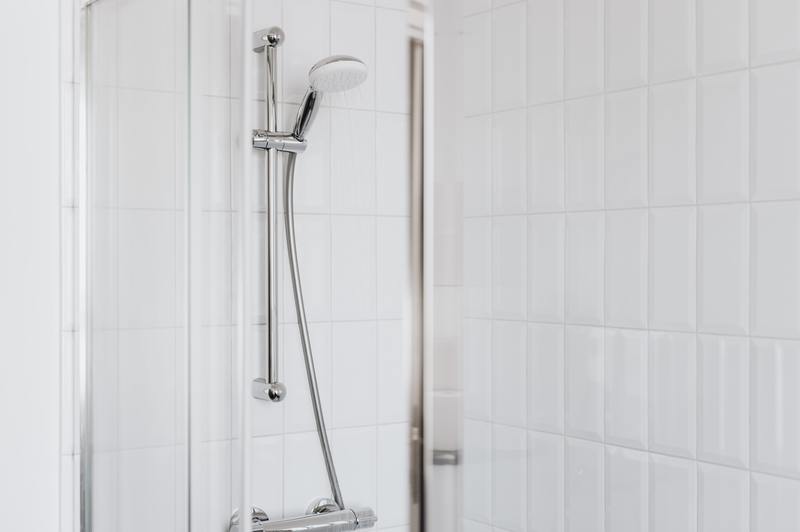One thing you should know about cleaning your bathroom is how to remove mildew from shower walls. After all, mildew can cause a variety of health issues such as triggering allergies or affecting the respiratory system.
Fret not because you can get rid of mildew using a few household ingredients. Read on below for what you may need.

How To Get Rid Of Mildew On Bathroom Walls
Method #1. Bleach
One go-to solution may be old-fashioned chlorine bleach. Apply the bleach to the affected area and let it sit for 30 minutes.
After that, you can start scrubbing off any mold or mildew on the walls. Rinse with warm water once it’s cleaned.
Quick reminder though: make sure the wall’s material can withstand the strength of bleach. If it’s made of a material such as colored grout, for example, the bleach can cause the color to fade.
Method #2. Vinegar
Aside from bleach, you can use other common household items to get rid of any mildew. The most common go-to is vinegar.
It may come as a surprise to you how vinegar can be used as a cleaning agent. Yes, you can use it to clean off the mildew from your bathroom walls.
Fill a spray bottle with white vinegar and spray liberally on areas with mildew. Let it sit for at least 30 minutes like with the bleach.
Once enough time has passed, you can start scrubbing away.
Method #3. Baking soda
If there’s any stubborn mildew remains, you can create a baking soda paste.
Mix three parts baking soda and one part water. Lather on any mildew remnants and spray more vinegar.
Again, you can brush off the mildew. If some mildew stains are remaining, repeat the process until there’s no more mildew in sight.
Method #4. Hydrogen peroxide
It’s important to note that there may still be some tough mildew stains despite doing the above process. Don’t worry though.
If worse comes to worst, you can use hydrogen peroxide. Rinse the area you’ve cleaned, pour the hydrogen peroxide into a spray bottle, and spray the affected areas.
Remember, exercise extreme caution as hydrogen peroxide mixed with vinegar can be highly toxic.
In line with keeping your bathroom clean, you may want to know how to do a more in-depth cleaning of your bathroom walls or even floor tiles. To start, we have a handy guide on how to remove mildew from shower grout.
Now that we’ve covered what you need to know about cleaning off mildew, we can go over how to prevent it in the future.
How To Prevent Mildew
To better take action in preventing mildew, it’s important to know where it comes from.
To recap, mold can thrive in areas with high humidity or moisture levels. Your bathroom can become more prone to mildew during the winter months when you crank up the indoor heating.
The chances increase when you have pipes leaking into your bathroom. The wet surfaces resulting from leaks provide a good breeding ground for mildew or other types of mold.
Keeping all this in mind, it’s important to keep your bathroom well ventilated.
If your bathroom has a window, keep it open to let some fresh air in. In addition, you can keep your exhaust fan running for at least 30 minutes after bathing.
If your bathroom doesn’t have a window, your exhaust fan can still suffice. For better results, you can leave it on a little longer than the usual 30 minutes.
If you can, you can invest in a dehumidifier. Make sure that the humidity levels are at 50 to lessen the chance of mildew growing and spreading.
With regards to leaky pipes, get them fixed right away before any mildew has a chance to thrive.
If you see small puddles or droplets on the walls, dry them up immediately. It’s better to prevent areas in your bathroom from becoming potential breeding grounds for mildew.
Aside from controlling humidity levels or moisture, you can also prevent mildew by keeping your bathroom well lit. Mildew also thrives in dark areas.
If your bathroom has a window, let any blinds you have up so that natural light can help prevent mold or mildew from growing.
If you don’t have a window, you can simply keep the lights on longer than usual after you use the bathroom. 10 to 15 minutes is a good amount of time to reduce the chances of mildew manifesting.
So far, we’ve covered the basics of what you need to know about mildew. However, you may be thinking of when you need to take drastic measures.
Fortunately for you, we have a wide variety of resources that’ll help you. If you’re wondering how long does it take for mildew to grow, for example, we’ve got you covered.
Conclusion
Mildew can be a recurring problem but now you’re equipped with what you need to know to get rid of it. With a few household materials at your disposal, you can get rid of mildew in no time.
Of course, it helps to take measures to prevent it or at least reduce the chance of mildew growth. Now that we’ve covered the basics, figuring out how to remove mildew from shower walls won’t be too much of a problem.
